environmental-social-governance
9 MIN REPORT
When it comes to environmental, social and governance (ESG) issues, recent media coverage has understandably centered on energy transition and security. And yet, there are many other ESG-related considerations shaping investment opportunities across various sectors.
Looking beyond the energy headlines, some of our ESG specialists and investment analysts share their views on five key ESG issues influencing their thinking.
Hard pill to swallow: Recalls in pharmaceuticals
The global pharmaceutical industry has been fined over USD 95 billion in civil and criminal financial penalties since 2000, according to the estimates by Violation Tracker as of April 2023.
Product safety issues can result in harm to the end-consumer, costly product recalls, loss of market share, heightened regulatory scrutiny, as well as expensive legal liabilities. Despite these risks, product safety is one of the many often underappreciated “S” or social issues that can materially affect biotechnology and pharmaceutical companies.
When it comes to assessing product quality and safety for a given company, our investment analysts draw on data from a variety of sources — including the U.S. Food and Drug Administration (FDA), Bloomberg and Refinitiv — in order to track warning letters, product recalls and customer health and safety controversies. Form 483 filings are issued to companies when an investigator observes manufacturing conditions that may violate the Food Drug and Cosmetic Act and can be used to help quantify product safety concerns in biotechnology and pharmaceutical companies.
“When I consider the range of material ESG risks in biopharma, product safety and litigation are top of mind. A company’s reputation and bottom line can take substantial hits from fines and recalls. Monitoring of Form 483 filings by the FDA is a crucial aspect of tracking product risk across my area of coverage,” says equity investment analyst, Judith Finegold.
Robust internal quality oversight and accountability are key in helping manage product safety risks. For example, Eli Lilly’s Global Quality team of 2,500 scientists, pharmacists and other health care professionals provides oversight throughout the product lifecycle to help keep the firm compliant with regulatory standards. These efforts have helped keep the number of product recalls below the biopharma peer average over the last three years. That said, it’s important to note: this metric is not all-encompassing. Our investment analysts and portfolio managers assess a range of product quality and safety metrics to inform their individual investment theses.
Ultimately, fewer product recalls and litigation costs mean that companies can choose to focus more of their spending on potentially revenue-generating investments in research, development and product deployment.
The U.S. FDA typically flags hundreds of potential regulatory violations each year
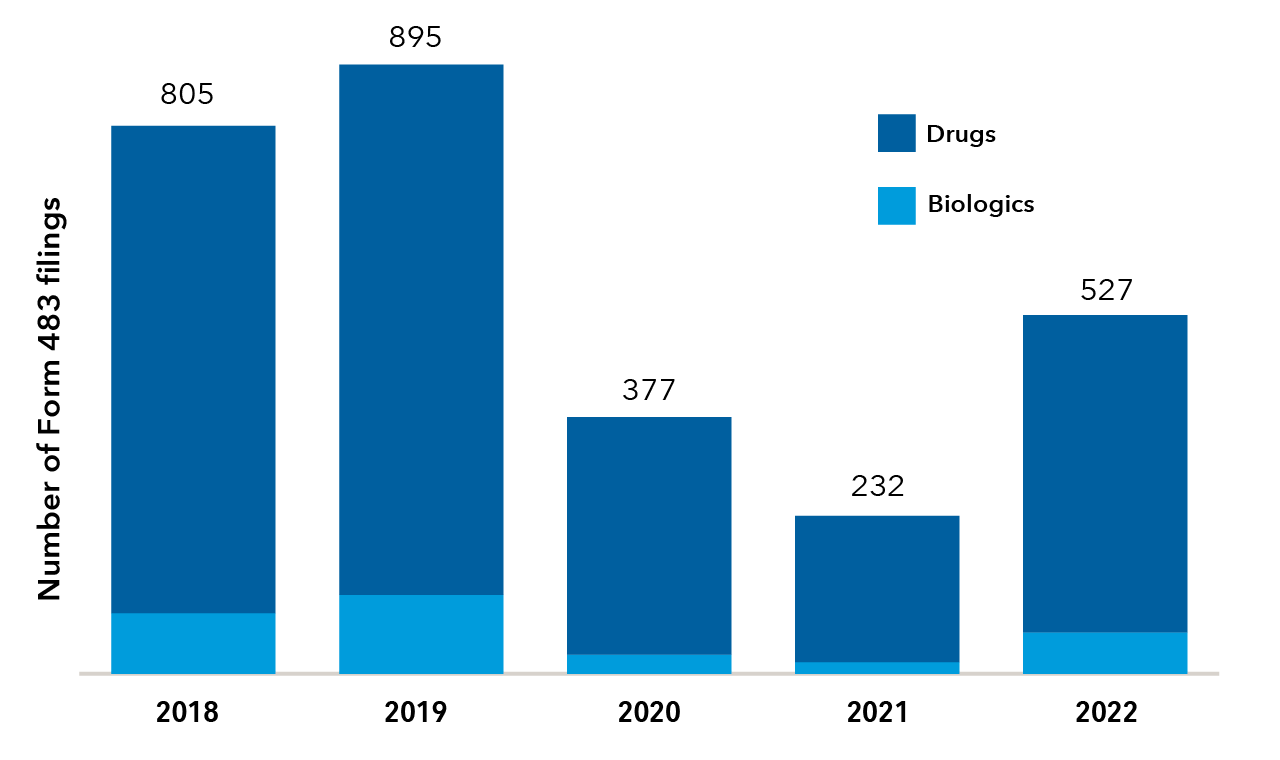
Sources: U.S. Food and Drug Administration (FDA). Data through September 30, 2022. Form 483 filings are issued to companies when an investigator observes manufacturing conditions that may violate the Food Drug and Cosmetic Act and can be used to quantify product safety concerns in biotechnology and pharmaceutical companies.
Showing their metal: Lithium sourcing for auto manufacturers
An electric vehicle (EV) requires six times the amount of minerals that a conventional gas-powered car needs, according to the International Energy Authority (IEA) as of March 2022. Lithium is one of the main raw materials used to manufacture EV batteries.
The IEA predicts that, by 2050, in a net zero scenario lithium demand could be nearly 26 times as large as in 2022. High water consumption and potential infringement of indigenous rights are among the significant sustainability and regulatory risks posed by lithium mining and processing. In Germany, for example, companies found in violation of the Supply Chain Due Diligence Act can be fined up to 2% of annual revenues. Sustainable sourcing is, therefore, becoming a key priority of many automakers.
Capital Group’s in-house ESG data platform, Ethos, draws together a number of third-party data sources to give a picture of company initiatives to reduce social risks in their supply chains, including the number of supplier audits conducted. Our investment analysts are able to leverage this data, among other sources, to help assess supply chain risk across auto manufacturers.
“We’ve seen certain legacy automakers with a smaller manufacturing footprint lead the way when it comes to sustainability in supply chains,” says fixed income investment analyst, Danny Jacobs. “Sourcing of raw materials [such as lithium] and broader supply chain transparency are examples of ESG considerations that can have financial consequences due to repercussions on operations and emissions,” Danny adds.
BMW, the first auto manufacturer to join the Initiative for Responsible Mining Assurance (IRMA), has pledged transparency and direct sourcing from raw materials producers in Australia and Argentina. The company has also partnered with U.S.-based lithium supplier Livent, among other producers, in an effort to diversify their supply chain and leave production operations less vulnerable to disruption.
Autos showing their metal? ESG risk management in raw minerals
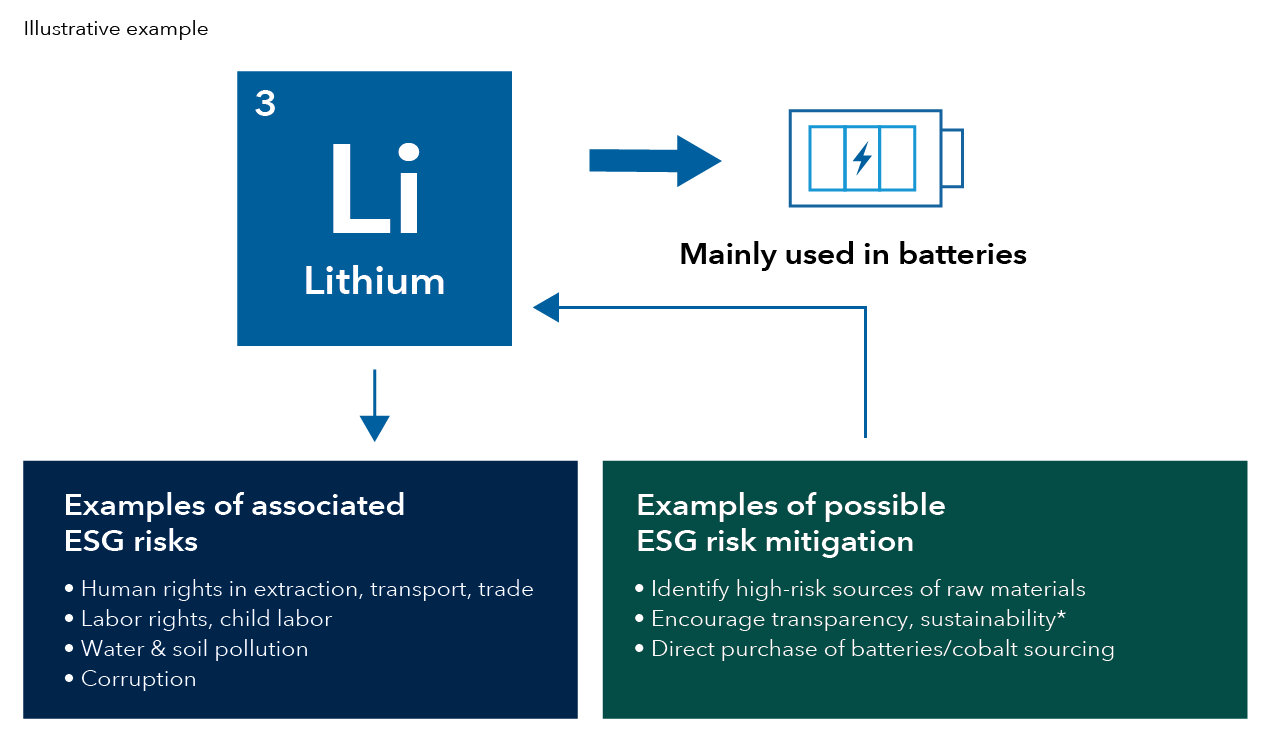
*For example, industry initiatives for responsible sourcing, sustainable battery production, certification of smelters/refiners.
Sources: Capital Group, BMW.
Effective government: Governance among sovereigns
Governance-related issues such as board composition, executive compensation and succession planning are widely understood as significant considerations among corporate equity and bond investors.
For investors in sovereign bonds, however, “G” or governance-related issues are no less important. Governance is a critical consideration in sovereign credit rating models and valuations, and helps investment professionals assess a country’s political stability, regulatory effectiveness and risk of corruption.
Our sovereign bond investment analysts use the World Bank’s Worldwide Governance Indicators as one of many inputs to monitor performance on governance metrics. Changes or flags in corruption rankings, government effectiveness, political stability and regulatory quality are among the metrics that can help inform the investment thesis.
“The absence of a risk or flag, however, does not mean there are no risks. Improvements or declines are not necessarily linear,” says sovereign investment analyst, Holger Siebrecht.
Angola is an example of a sovereign issuer that has demonstrated meaningful improvements in their control of corruption and regulatory quality scores. Those improvements reflect the Lourenço administration’s anti-corruption campaigns and the privatization of several state-owned enterprises, which have helped to reduce the scope for corruption and patronage. In early 2022, Fitch Ratings agency raised Angola's Long-Term Foreign-Currency Issuer Default Rating from CCC to B-.
That said, progress in governance has not been across the board. Rule of law and voice and accountability scores declined slightly compared to the prior year − underscoring the importance of assessing multiple indicators when evaluating investment risk.
Angola has improved governance with new anti-corruption initiatives
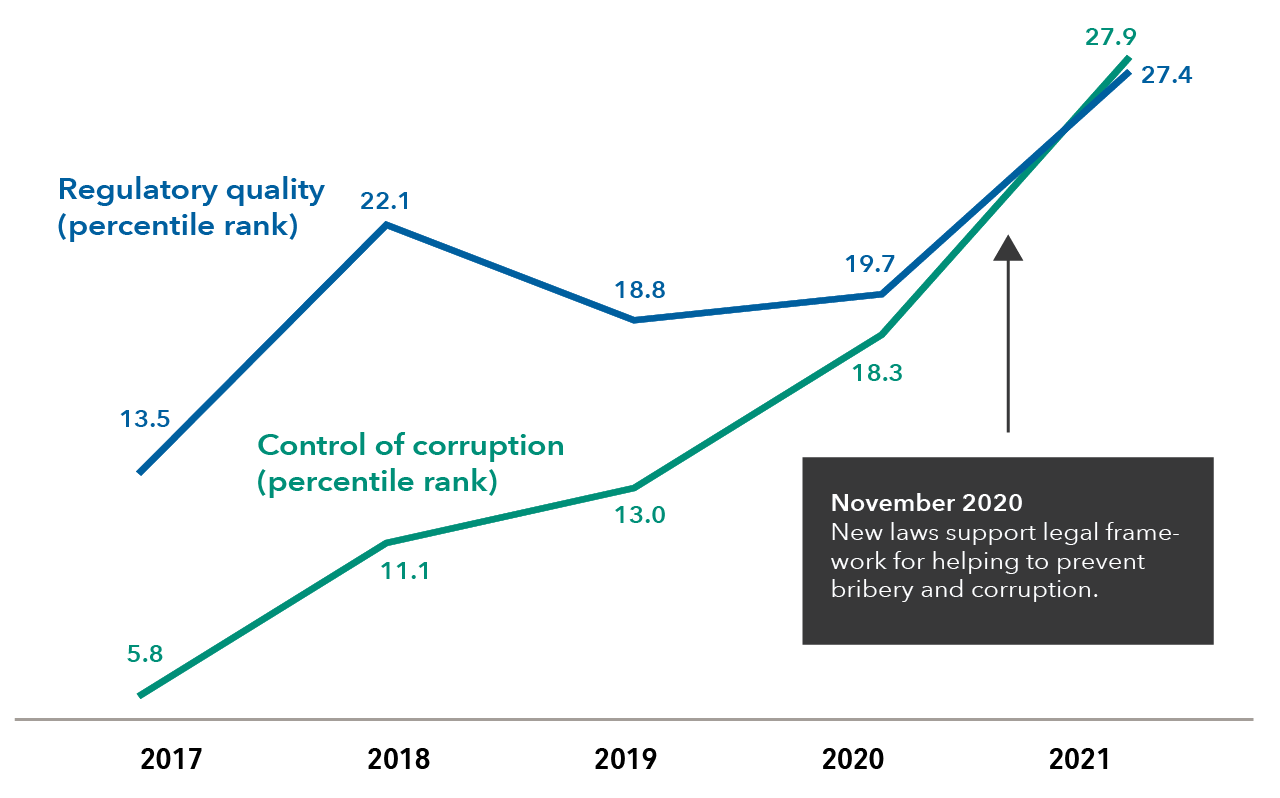
Source: World Bank Worldwide Governance Indicators. Data published as of September, 2022. Scores shown are percentile ranks; ranging from 0-100.
Liquid risk: Water usage among chip makers
The world is expected to face a global freshwater shortfall of up to 40% by 2030, according to the United Nations as of April 2023. While environmental concerns are largely recognized as broad ESG issues, the use of water across a wide range of industries presents an often overlooked ESG consideration.
Semiconductors, essential components in technology such as smartphones, rank top three among the most water-intensive sectors. Large amounts of ultra-pure water are required during the wafer manufacturing process to avoid the contamination of devices. A typical manufacturing facility uses 2-4 million gallons of ultra-pure water per day, according to Sustainalytics as of March 2017, or the equivalent daily water usage for roughly 13,000 households.
Our ESG specialists conducted research to understand how water risk can threaten companies’ bottom lines. “The greatest cost to companies will come from interrupted operations, project cancellations and difficulty obtaining environmental permits rather than rising water prices,” explains ESG specialist, Emma Doner.
Our ESG and investment analysts leverage the World Resources Institute Aqueduct Tool to understand where water-stress risk is most pronounced and then map those regions against a company’s operations. Amid a push to diversify manufacturing sites, semiconductor companies such as Intel and Taiwan Semiconductor Manufacturing Company (TSMC) have expanded operations to areas including the southwest United States – a region under extreme water stress.
Despite anticipated water shortages in the region, Intel is confident they will be able to access the water necessary for continued operations. Intel’s unique water treatment and recycling facility allows the company to treat nearly 9 million gallons of water each day, which it can reuse. Combined with other internal conservation methods, the company is able to save over 9 billion gallons of water annually. Similarly, competitor TSMC expects its new microchip plant in Arizona to achieve close to a 90% water recycling rate.
Not only do water management practices help these semiconductor companies avoid business continuity risk, but they can now also fulfill the demands of clients requiring low-water, low-energy produced products.
Triple threat? The three largest semiconductor firms could face significant water stress
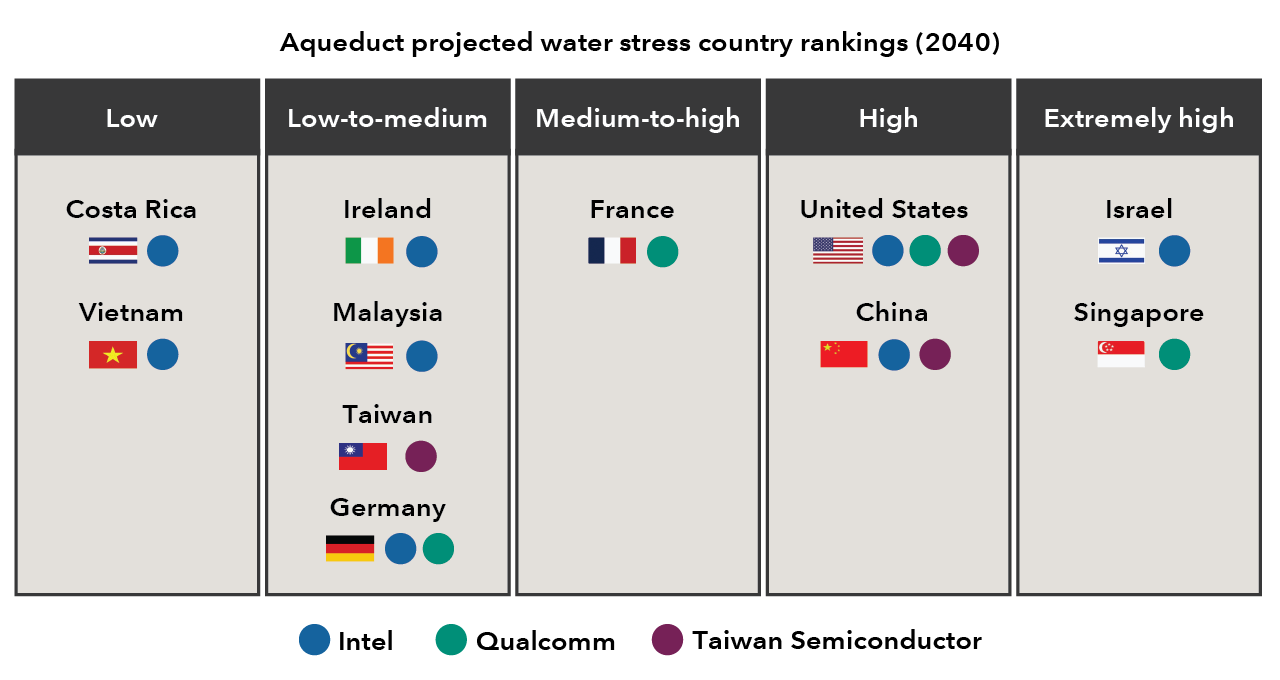
Water stress measures total annual water withdrawals expressed as a percentage of the total annual available water. Colored dots indicate manufacturing locations sourced from company websites, for illustrative purposes only. 53% of the manufacturing countries for the three largest semiconductor companies are ranked as medium-to-high, high, or extremely high water-stressed areas in 2040 projections. Taiwan Semiconductor, Intel and Qualcomm are the three largest semiconductor companies by revenue, as of January 2023 according to Investopedia.
Source: Luo, T., R. Young, and P. Reig. 2015. "Aqueduct projected water stress rankings." World Resources Institute Projected Water Stress Country Rankings. Manufacturing locations gathered from the Intel, Taiwan Semiconductor and Qualcomm company websites, respectively.
Robot rules: AI and consumer data
Adoption of artificial intelligence (AI) is projected to grow more than fourfold by 2027, from $86.9 billion in 2022 to a market size of over $407 billion, according to a MarketsandMarkets report in November 2022. Increased use of the technology is helping firms optimize divisions such as marketing, manufacturing, and operations, and cut costs.
“We’re at an inflection point for AI implementation and it’s going to profoundly change the world, full stop. Data privacy will, therefore, become even more of a key source of reputational and legal risks for AI developers and the businesses adopting their technology,” says equity investment analyst, Mihir Mehta.
Broader AI usage brings up the question of AI ethics, an emerging ESG issue across various sectors. Risk of inappropriate data usage, as well as use of AI for malintent, introduces regulatory scrutiny, litigation costs and reputational risks. Because of this, new governance or “G” issues are emerging in this space, and oversight groups that manage these risks are proving increasingly important in this evolving regulatory landscape.
According to research conducted by our ESG analysts, companies are setting up voluntary governance principles for AI focused on six themes: human rights, non-discrimination, accountability to humans, data security, privacy and explainability. These indicators can help Capital Group investment analysts assess companies and issuers in areas such as data collection, governance and privacy practices.
Some companies are paving the way for future norms. Both Microsoft and Alphabet have been first-movers in setting AI ethics policies. Microsoft was one of the first firms to develop a responsible AI standard, outlining a transparent, evolving set of rules that govern how its customers use AI applications. Microsoft recently edited its principles to state that companies cannot use its technology to infer emotion, gender or age using facial recognition technology. That said, ensuring these principles can be upheld will pose a major challenge. While companies have responded swiftly with policies to help improve user safety, for products such as AI-powered chat, there is still a substantial amount to be learned.
Investment in AI is becoming a bigger part of corporate budgets
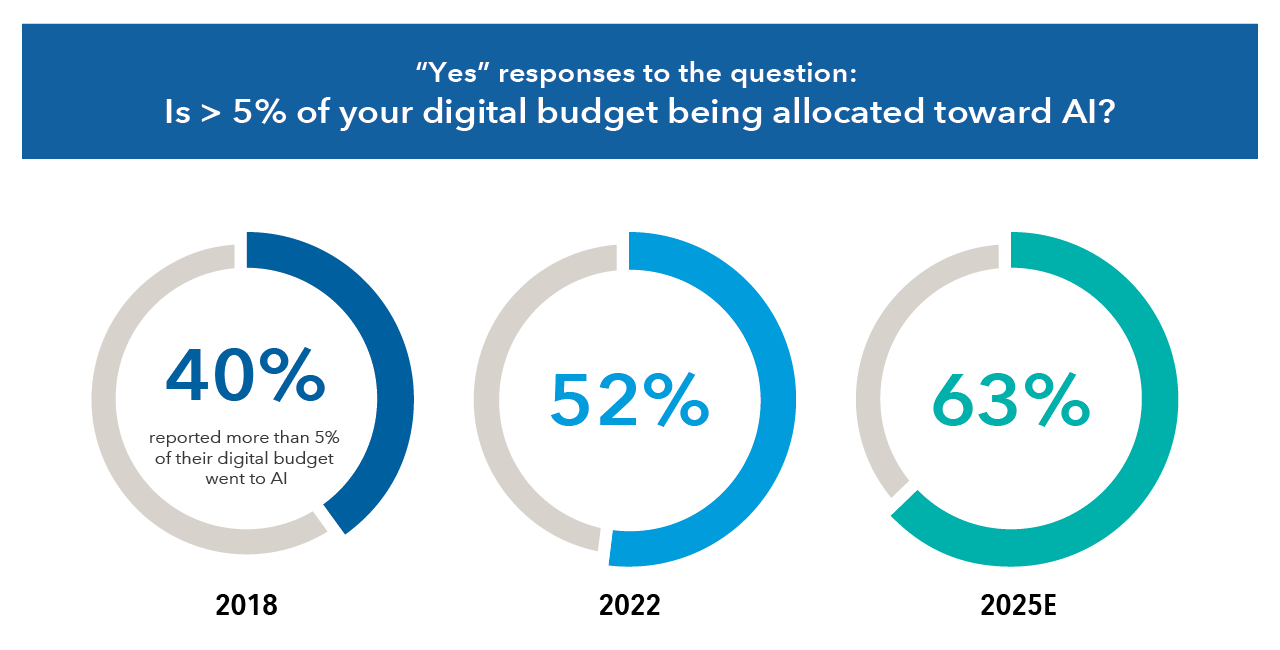
Source: McKinsey, “The state of AI in 2022 − and half a decade in review” survey, conducted May 3-27, 2022 and August 15-17, 2022. Data as of December 6, 2022. 2025 based on respondents anticipated spend.
Explore the latest research and insights in our ESG perspectives library
